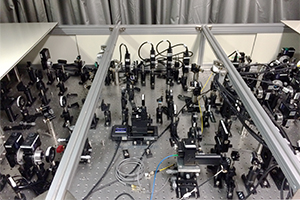 |
|||||||||||||||
|
|
|||||||||||||||
|
Short Reports Vol. 17, No. 7, pp. 44–46, July 2019. https://doi.org/10.53829/ntr201907sr3 First Proof-of-principle Experiment of Quantum Repeaters with All Photonics—Major Step towards
|
|||||||||||||||
| *1 | Quantum internet: In the field of quantum information, a quantum internet describes a global quantum-communication network that enables the exchange of quantum information—which is represented by quantum superposition states—between arbitrary information-processing devices all over the world. |
| *2 | Matter quantum memory: Quantum memory is the function to store the quantum superposition states for a certain period of time. For instance, in contrast to the memory in conventional computers that can store both bit values 0 and 1, quantum memory can store not only 0 and 1 but also their quantum superposition states. A matter quantum memory is the realization of quantum memories based on matter such as an atomic ensemble, a single atom, an ion trap, a quantum dot, a superconducting qubit, and a nitrogen-vacancy center in a diamond. |
| *3 | Quantum entanglement: A quantum superposition state of composite systems that can never be expressed by any collection of the descriptions of the subsystems. This is an essential resource for quantum communication and quantum computation. The existence has already been experimentally demonstrated by using photons and atoms. |
3. Research results
Prof. Yamamoto’s group at Osaka University, in collaboration with NTT, the University of Toyama, and the University of Toronto, has successfully demonstrated experimentally a key component of all-photonic quantum repeaters—the time reversal. This corresponds to a first proof-of-principle experiment of all-photonic quantum repeaters.
This demonstration indicates that not only all-photonic quantum repeaters but also a global all-photonic quantum internet is possible once ultralow-loss integrated optics and efficient entanglement light sources are available. At the same time, the current demonstration also corresponds to a first proof-of-principle experiment of an adaptive Bell measurement,*4 which is required for arbitrary quantum repeater schemes (including the conventional approach with matter quantum memories). This suggests that the all-optical approach is one-step closer to achieving quantum repeaters than conventional approaches.
| *4 | Adaptive Bell measurement: The Bell measurement is a measurement on a pair of particles to reveal which state of possibly maximally entangled states has been taken by the pair of particles. Each quantum repeater needs to perform the Bell measurement on a pair of particles, on confirming that each particle shares quantum entanglement with other repeater nodes. This Bell measurement performed in an adaptive manner is called adaptive Bell measurement. |
4. Future prospects
This experiment showed that the all-photonic repeater approach has a promising advantage compared to the other approaches with matter quantum memories for building a worldwide quantum internet. The next steps towards achieving the quantum internet with the all-photonic repeaters are developing large-scale graph-state photon generators and ultralow-loss photonic circuits so as to be able to perform a larger-scale adaptive Bell measurement. This experiment is merely a first step. However, it is essential for achieving a future energy-efficient high-speed quantum internet, where we are able to enjoy absolutely secure communication, uncopiable money, secure e-commerce, longer-baseline telescope arrays, a single international clock with high stability and accuracy, cloud quantum computing, large-scale quantum computer networks, and other benefits.
This work was published in the journal Nature Communications on January 28, 2019 [3]. This research is in part executed under a project of the Japan Science and Technology Agency CREST called ‘Creation of an innovative quantum technology platform based on the advanced control of quantum states,’ ‘Global quantum network’ (Research director: Nobuyuki Imoto). It is also supported by the Ministry of Education, Culture, Sports, Science and Technology/Japan Society for the Promotion of Science KAKENHI, and the Center for Promotion of Advanced Interdisciplinary Research of the Graduate School of Engineering Science, Osaka University.
References
| [1] | K. Azuma, K. Tamaki, and H. Lo, “All-photonic Quantum Repeaters,” Nat. Commun., Vol. 6, Article no. 6787, 2015. |
|---|---|
| [2] | Press release issued by NTT, “Against a Dogma, Quantum Repeaters for Long-distance Quantum Communication Are Made All Photonic.—Rendering the Quantum Internet an Ultimate Challenge for the Future Photonic Network,” Apr. 15, 2015.
http://www.ntt.co.jp/news2015/1504e/150415a.html |
| [3] | Y. Hasegawa, R. Ikuta, N. Matsuda, K. Tamaki, H. Lo, T. Yamamoto, K. Azuma, and N. Imoto, “Experimental Time-reversed Adaptive Bell Measurement towards All-photonic Quantum Repeaters,” Nat. Commun., Vol. 10, Article no. 378, 2019. |
For inquiries:
Public Relations, NTT Science and Core Technology Laboratory Group









